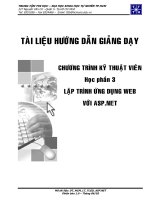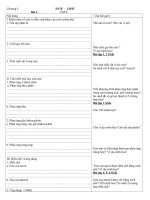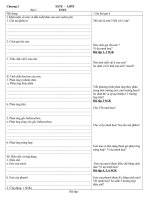- Trang chủ >>
- Lịch sử >>
- Lịch sử lớp 10
tài liệu giảng dạy « website của đinh tiên minh phd
Bạn đang xem bản rút gọn của tài liệu. Xem và tải ngay bản đầy đủ của tài liệu tại đây (709.35 KB, 9 trang )
<span class='text_page_counter'>(1)</span><div class='page_container' data-page=1>
2
<b>C H A P T E R</b>
© 2014 Cengage Learning. All Rights Reserved. May not be scanned, copied or duplicated, or posted to a publicly accessible website, in whole or in part.
Strategic
Marketing
Planning
Chapter outline
Introduction
The strategic planning process
The marketing plan
Maintaining customer focus and balance in
</div>
<span class='text_page_counter'>(2)</span><div class='page_container' data-page=2>
© 2014 Cengage Learning. All Rights Reserved. May not be scanned, copied or duplicated, or posted to a publicly accessible website, in whole or in part.
Situation Analysis
<i>An in-depth analysis of the organization’s internal and external </i>
<i>environments</i>
Marketing Plan
<i>A written document that provides the blueprint or outline of </i>
<i>the organization’s marketing activities, including the </i>
<i>implementation, evaluation, and control of those activities</i>
Explains how the organization will achieve its goals and
objectives
Serves as a “road map” for implementing the marketing strategy
Instructs employees as to their roles and functions
Provides specifics regarding the allocation of resources, specific
marketing tasks, responsibilities of individuals, and the timing of
marketing activities
The Strategic Planning Process
3
The Strategic Planning Process
(Exhibit 2.1)
</div>
<span class='text_page_counter'>(3)</span><div class='page_container' data-page=3>
© 2014 Cengage Learning. All Rights Reserved. May not be scanned, copied or duplicated, or posted to a publicly accessible website, in whole or in part.
Mission Statement
<i>Answers… “What business are we in?”</i>
<i>Clear and concise</i>
<i>Explains the organization’s reason for existence</i>
Vision Statement
<i>Answers… “What do we want to become?”</i>
<i>Tends to be future oriented</i>
<i>Represents where the organization is headed</i>
Organizational Mission versus
Organizational Vision
5
Five basic questions to be answered
<i>Who are we?</i>
<i>Who are our customers?</i>
<i>What is our operating philosophy?</i>
<i>What are our core competencies or competitive advantages?</i>
<i>What are our responsibilities with respect to being a good steward of </i>
<i>our human, financial, and environmental resources?</i>
Mission Width and Stability
<i>Width – too broad or too narrow?</i>
<i>Stability – frequency of modifications</i>
Customer-Focused Mission Statements
<i>Southwest Airlines</i>
</div>
<span class='text_page_counter'>(4)</span><div class='page_container' data-page=4>
© 2014 Cengage Learning. All Rights Reserved. May not be scanned, copied or duplicated, or posted to a publicly accessible website, in whole or in part.
The Best Mission Statements
(Exhibit 2.2)
7
The central means for:
<i>Utilizing and integrating the organization’s resources</i>
<i>Carrying out the organization’s mission</i>
<i>Achieving the organization’s desired goals and objectives</i>
Leverages the firm’s capabilities that give it a
<i>competitive, or differential, advantage</i>
Determines the nature and future direction of each
business unit
Essentially the same as corporate strategy in small
businesses
Corporate or Business-Unit Strategy
</div>
<span class='text_page_counter'>(5)</span><div class='page_container' data-page=5>
© 2014 Cengage Learning. All Rights Reserved. May not be scanned, copied or duplicated, or posted to a publicly accessible website, in whole or in part.
All business functions must support the
organization’s mission and goals.
Functional objectives should be expressed in clear,
simple terms.
All functional objectives should be reconsidered for
each planning period.
Functional Goals and Objectives
9
Functional strategies are designed to integrate
efforts focused on achieving the area’s stated
objectives.
The strategy must:
<i>Fit the needs and purposes of the functional area</i>
<i>Be realistic with the organization’s resources and environment</i>
<i>Be consistent with the organization’s mission goals, and </i>
<i>objectives.</i>
The effects of each functional strategy must be
evaluated.
</div>
<span class='text_page_counter'>(6)</span><div class='page_container' data-page=6>
© 2014 Cengage Learning. All Rights Reserved. May not be scanned, copied or duplicated, or posted to a publicly accessible website, in whole or in part.
Involves activities that execute the functional
strategy
Functional plans have two target markets:
<i>External market</i>
<i>Internal market</i>
A company must rely on its internal market – its
employees – for a functional strategy to be
implemented successfully.
Implementation
11
Defend or contradict this statement:
Developing marketing strategy is
more important than implementing
marketing strategy because if the
strategy is flawed, its implementation
doesn’t matter.
</div>
<span class='text_page_counter'>(7)</span><div class='page_container' data-page=7>
© 2014 Cengage Learning. All Rights Reserved. May not be scanned, copied or duplicated, or posted to a publicly accessible website, in whole or in part.
Designed to keep planned activities on target with
goals and objectives
Coordination and open communication among
functional areas are critical issues
Evaluation and control is both an ending and
beginning
<i>Occurs after a strategy has been implemented</i>
<i>Serves as the beginning point for planning in the next cycle</i>
Evaluation and Control
13
Detailed formulation of the actions needed to carry
out the marketing program; an action document –
the handbook for marketing implementation,
evaluation, and control
Not the same as a business plan
Requires a great deal of information from many
different sources
Should be well organized. A good marketing plan
outline is:
<i>Comprehensive</i>
</div>
<span class='text_page_counter'>(8)</span><div class='page_container' data-page=8>
© 2014 Cengage Learning. All Rights Reserved. May not be scanned, copied or duplicated, or posted to a publicly accessible website, in whole or in part.
I.
Executive Summary
Synopsis of the major aspects of the marketing plan
II.
Situation Analysis
Internal environment
Customer environment
External environment
III.
SWOT Analysis
Strengths, weaknesses, opportunities, threats
Analysis of the SWOT matrix
Developing competitive advantages
Establishing a strategic focus
Marketing Plan Structure
(Exhibit 2.3)
15
IV.
Marketing Goals and Objectives
Formal statements of desired and expected outcomes of
the marketing plan
Goals
Broad, simple statements of what is to be accomplished
Objectives
More specific performance targets
V.
Marketing Strategy
Primary (and secondary) target market
The marketing program
Branding and positioning strategy
Marketing Plan Structure
(Exhibit 2.3)
<i>(continued)</i>
</div>
<span class='text_page_counter'>(9)</span><div class='page_container' data-page=9>
© 2014 Cengage Learning. All Rights Reserved. May not be scanned, copied or duplicated, or posted to a publicly accessible website, in whole or in part.
VI.
Marketing Implementation
What specific marketing activities will be undertaken?
How will these activities be performed?
When will these activities be performed?
Who is responsible for the completion of these activities?
How will the completion of planned activities be
monitored?
How much will these activities cost?
VII.
Evaluation and Control
Formal marketing control
Informal marketing control
Financial assessments
Marketing Plan Structure
(Exhibit 2.3)
<i>(continued)</i>
17
Puts customer needs and wants first
Focuses on long-term, value-added relationships
Focuses on understanding customers in ways that
enhance sustainable competitive advantages
Instills a corporate culture that places customers at
the top of the organizational hierarchy
Finds ways to cooperate with suppliers and
competitors to serve customers more effectively
and efficiently
</div>
<!--links-->









